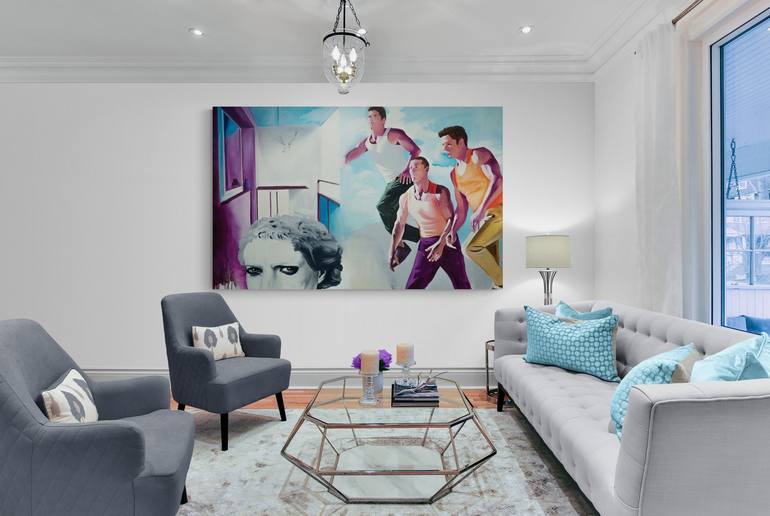Creating Artistic Photo Wall Backdrops: A Guide for Photographers
For professional photographers, the art of creating artistic photo wall backdrops is both a science and an art. It requires a keen eye for detail, a love for aesthetics, and a deep understanding of how to transform a simple wall into a masterpiece that elevates the subject of the photograph. In this comprehensive guide, we will explore the nuances of designing photo wall backdrops that not only capture attention but also tell a story.

Understanding the Importance of Photo Wall Backdrops
Photo wall backdrops are an essential element in any photographer's toolkit. They provide the perfect canvas for creating stunning visual narratives. A well-designed backdrop can make or break a photograph, adding depth, texture, and context to the image. For instance, a beautifully crafted backdrop can enhance a portrait by drawing focus to the subject, while a poorly chosen one can distract from the overall composition.
When creating artistic photo wall backdrops, it's crucial to consider the mood and theme of the shoot. Are you aiming for a rustic feel, a modern aesthetic, or something entirely unique? The backdrop should complement the subject and enhance the overall story you are trying to tell.
Choosing the Right Materials
The choice of materials plays a pivotal role in creating artistic photo wall backdrops. Depending on the desired effect, photographers can choose from a variety of materials such as fabric, wood, paper, or even digital projections. Each material offers its own set of advantages and can be tailored to fit the specific needs of the shoot.
Fabric Backdrops
Fabric backdrops are versatile and come in a wide range of textures and colors. They are ideal for creating soft, elegant backgrounds that add a touch of sophistication to portraits. Velvets, silks, and muslins are popular choices among photographers looking to create a classic, timeless look.
Wooden Backdrops
Wooden backdrops, on the other hand, provide a rustic and earthy feel. They are perfect for outdoor-themed shoots or when you want to add a touch of nature to your photographs. The texture and grain of the wood can add a layer of depth and interest to the image.
Color Schemes and Patterns
Color schemes and patterns are integral to the design of any photo wall backdrop. The right combination of colors can evoke specific emotions and set the tone for the entire shoot. For instance, soft pastels can create a serene and calming atmosphere, while bold and vibrant colors can inject energy and excitement into the scene.
Patterns, when used strategically, can add a dynamic element to the photograph. However, it's important to ensure that the patterns do not overpower the subject. As a rule of thumb, simpler patterns work best for portraits, while more complex designs can be used for artistic and conceptual shoots.
Incorporating Props and Lighting
Props and lighting are key components in creating artistic photo wall backdrops. Props can add character and context to the shoot, while lighting can highlight specific elements of the backdrop, creating depth and dimension. When used effectively, these elements can transform a simple backdrop into a captivating scene.
Experimenting with different lighting techniques, such as backlighting or side lighting, can create interesting shadows and highlights that enhance the overall composition. Similarly, incorporating props that are relevant to the theme can add layers of meaning to the image.
Creating No Frame Photo Wall Displays
For photographers looking to push the boundaries of traditional backdrops, creating no frame photo wall displays offers a unique and modern approach. These displays allow for a seamless integration of the photograph with the wall, creating a three-dimensional effect that is both innovative and visually striking.
Staying Inspired and Creative
In the ever-evolving world of photography, staying inspired and creative is essential. Photographers can draw inspiration from various sources, such as art, nature, architecture, and even everyday life. Keeping a journal of ideas and experimenting with new techniques can help in continuously evolving as an artist.
For more innovative ideas on using art in dcor, this guide on art decoration offers valuable insights into integrating artistic elements into your photography.
Personalizing Photo Walls for Family Rooms
One of the most rewarding aspects of creating artistic photo wall backdrops is the ability to personalize them for specific spaces. Personalizing photo walls for family rooms can create a warm and inviting atmosphere, turning a simple wall into a cherished memory space.
Conclusion
Creating artistic photo wall backdrops is a journey of creativity, experimentation, and expression. By understanding the importance of backdrops, choosing the right materials, and incorporating elements like color, pattern, props, and lighting, photographers can craft compelling visual stories that resonate with viewers. As you continue to explore this art form, remember that the possibilities are endless, and each backdrop is an opportunity to create something truly unique.

FAQs
What materials are best for creating photo wall backdrops?
Choosing the right materials depends on the desired look and feel of your backdrop. Fabrics like velvet and muslin offer a soft, elegant finish, while wood can add a rustic touch. Consider the theme of your shoot to select the most appropriate materials.
How can I make my photo wall backdrop unique?
Experimentation is key. Incorporate unique props, play with lighting techniques, and use unexpected color schemes to make your backdrops stand out. Personalization, such as photo-based painting, can also add a special touch.
Are there any innovative ideas for modern photo backdrops?
Yes, modern backdrops like no-frame photo wall displays offer a fresh take on traditional designs. These backdrops provide a seamless integration with the wall, creating a unique three-dimensional effect.

